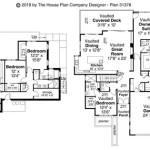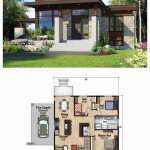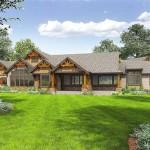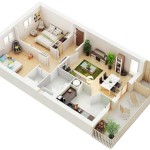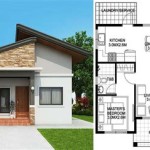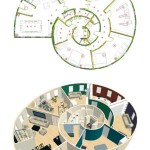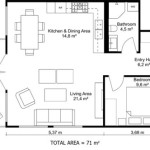Small 2 Bedroom House Plans And Designs With Dimensions In Meters
The demand for small, efficient housing continues to rise, driven by factors ranging from affordability to environmental concerns. Two-bedroom house plans represent a practical solution for individuals, couples, and small families seeking a manageable living space without sacrificing essential functionalities. This article explores various aspects of small two-bedroom house plans and designs, focusing on dimensions in meters, layout considerations, space optimization techniques, and examples of popular design styles.
Designing a small two-bedroom house requires careful planning and consideration of every square meter. Maximizing usable space is paramount, and achieving this necessitates a strategic approach to layout design, furniture selection, and storage solutions. The overall goal is to create a comfortable and functional living environment that feels more spacious than its actual dimensions might suggest. This involves an understanding of architectural principles, interior design aesthetics, and the specific needs of the occupants.
Understanding Space Optimization in Small House Designs
Space optimization is not merely about minimizing clutter; it's about intelligently utilizing every available area within the house. This begins with the floor plan and involves a holistic approach that integrates architectural features with interior design elements. Several strategies contribute to maximizing space in a small two-bedroom house:
Open-Concept Living: Open-plan layouts, combining the living room, dining area, and kitchen into a single, unified space, create a sense of spaciousness. Eliminating dividing walls allows for better natural light penetration and enhances visual connectivity. Strategic furniture placement can then define different zones within the open area.
Vertical Space Utilization: Maximizing vertical space is critical in small homes. High ceilings, if structurally feasible, can create a more airy and open feel. Utilizing wall-mounted shelves, cabinets that reach the ceiling, and lofted storage areas can significantly increase storage capacity without encroaching on floor space.
Multi-Functional Furniture: Furniture that serves multiple purposes is a valuable asset in small homes. Sofa beds, fold-away tables, storage ottomans, and modular furniture systems can adapt to different needs throughout the day, making the most of limited space.
Built-In Storage: Custom-built storage solutions, such as under-stair storage, window seat storage, and integrated wardrobes, can provide ample storage without taking up valuable floor space. These solutions can be tailored to the specific dimensions and needs of the house.
Light and Color: The use of light and color can significantly impact the perceived size of a room. Light, neutral colors reflect light and create a more open and airy feel, while darker colors can make a room feel smaller and more enclosed. Maximizing natural light through large windows and skylights is also essential.
Key Considerations for 2 Bedroom House Plans (Dimensions in Meters)
Developing a two-bedroom house plan with dimensions in meters requires precise measurements and a clear understanding of spatial relationships. Several factors influence the optimal layout and dimensions of each room:
Overall Footprint: The overall size of the house will dictate the size of each room. Typical small two-bedroom houses range from 50 to 80 square meters. Within this range, careful allocation of space is essential to ensure adequate functionality in each area.
Bedroom Sizes: Master bedrooms generally require more space than secondary bedrooms. A master bedroom should ideally be at least 3 meters by 3.5 meters (10.5 square meters) to comfortably accommodate a queen-size bed, bedside tables, and a wardrobe. A secondary bedroom can be slightly smaller, around 2.5 meters by 3 meters (7.5 square meters), suitable for a single or double bed and small storage.
Living Area: The living area should be large enough to accommodate seating, entertainment equipment, and possibly a dining area. A minimum size of 4 meters by 5 meters (20 square meters) is recommended for a combined living and dining space. The shape of the room can also influence its usability, with rectangular shapes generally being more practical than irregular shapes.
Kitchen Area: The kitchen requires adequate counter space, storage, and room for appliances. A galley-style kitchen can be an efficient solution for small spaces, typically occupying an area of 2 meters by 3 meters (6 square meters). Open-plan kitchens integrated into the living area may require slightly more space, around 3 meters by 4 meters (12 square meters).
Bathroom: A standard bathroom in a small house typically measures around 1.5 meters by 2 meters (3 square meters). This should be sufficient for a toilet, sink, and shower. Installing a shower-tub combination can save space compared to having separate shower and tub units.
Circulation Space: Hallways and corridors should be kept to a minimum to avoid wasting space. A minimum width of 1 meter is recommended for hallways to allow for comfortable movement. Open-plan layouts can reduce the need for hallways, further optimizing usable space.
Outdoor Spaces: Even in a small house, incorporating outdoor spaces such as balconies, patios, or small gardens can significantly enhance the living experience. These spaces can extend the living area and provide a connection to the outdoors. Dimensions for these spaces depend on the overall site and personal preferences.
Examples of 2 Bedroom House Designs and Layouts
Numerous design styles and layout options can be adapted to suit a small two-bedroom house. Here are a few examples:
Linear Design: This layout features a simple, rectangular footprint with rooms arranged along a central hallway. The bedrooms are typically located at one end of the house, while the living area and kitchen are at the other. This configuration is efficient and easy to construct.
L-Shaped Design: An L-shaped layout provides a more dynamic floor plan, creating distinct zones for living and sleeping. The intersection of the "L" often serves as the entrance or a transition area. This design can be well-suited for corner lots or properties with specific landscape features.
Courtyard Design: A small courtyard house features a central courtyard surrounded by rooms. This design provides privacy and natural light to multiple rooms. While requiring a slightly larger footprint, the courtyard creates a central outdoor living space.
Duplex Design: A duplex design involves two dwelling units sharing a common wall or floor. Each unit can be a two-bedroom house, offering independent living spaces. This option is suitable for multi-generational families or rental income opportunities.
Loft Design: In an upward extending design such as a loft, the second bedroom may be located on a mezzanine level, maximizing the open space on the ground level. This design style is popular in urban settings and can create a unique and contemporary living environment.
Minimalist Design: Characterized by clean lines, simple forms, and a focus on functionality, minimalist design is well-suited for small two-bedroom houses. This style minimizes clutter and emphasizes the essentials, creating a serene and uncluttered living space. Neutral color palettes, natural materials, and ample natural light are key elements of minimalist design.
Scandinavian Design: Similar to minimalist design, Scandinavian design prioritizes simplicity, functionality, and natural light. It incorporates light wood tones, cozy textiles, and a focus on creating a warm and inviting atmosphere. Scandinavian design is particularly well-suited for maximizing the available light during the darker months.
Contemporary Design: Contemporary design encompasses a wide range of styles, but it generally features clean lines, open floor plans, and a focus on incorporating modern materials and technologies. Contemporary two-bedroom houses may incorporate elements such as large windows, energy-efficient appliances, and smart home automation systems.
When selecting a design style, it is important to consider personal preferences, lifestyle needs, and the overall aesthetic of the surrounding environment. Working with an architect or designer can help to create a customized two-bedroom house plan that meets specific requirements and maximizes the potential of the available space and budget.

20x20 Small Home Floor Plans 6x6 Meter 2 Bed 1 Bath House 3d

The Best 2 Bedroom Tiny House Plans Houseplans Blog Com

Small 2 Bedroom House 8x6 Meter 26x20 Feet Full Layout Floor Plan

Two Bedroom Small House Plan Cool Concepts F6

20x20 Small Home Floor Plans 6x6 Meter 2 Bed 1 Bath House 3d

Small House Plans 7 5x11 With 2 Bedrooms Full Samhouseplans 011

Small House Plan 2 Bedroom Home Design Bed Study Granny Flat Plans

Simple 2 Bedroom Two Story House Plans Cottage And Cabin

Modern House Design Plans 9x7m With 2 Bedrooms Craftsman Ee

Small 2 Bedroom House Plan 101 M2 Or 1089 Sq Foot And Tiny Plans Metric Feet Inches Concept Blueprints Crazy
Related Posts

